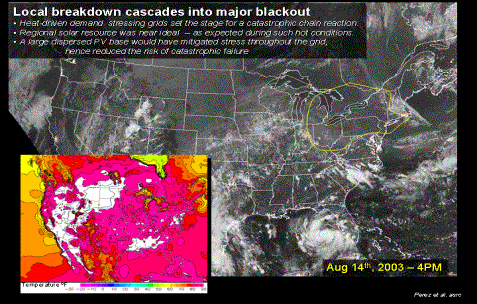
PRESS RELEASE
Contact: Christy Herig,
Principal
Segue Consulting
(727)-543-1285
August 15, 2003
We don’t know the exact cause of the August 14th
US/Canadian power outage, but it was an obvious demonstration of both countries’
vulnerability to loss of power. It’s
also known that the area was under an extreme heat wave and even at 4 PM, the
solar energy resource was nearly ideal as shown by the GOES satellite picture.
The next morning’s newscasts stated that alternatives to our current
power system are much too costly…but are the alternatives that costly?
What about solar and efficient use of energy?

First,
let’s consider some common myths about solar energy.
The greatest of these myths being the amount of land required for
photovoltaics, or solar electric panels commonly called PV.
·
A conservative
estimate of the solar energy reaching the ground in the United States is 1,500
kWh per square meter per year (actually ranging from 1200 to over 2000).
·
With 15%
solar-to-electricity conversion via PV[1],
usable energy is 1500x0.15
= 225 kWh/sq.m/yr[2].
·
Assuming that
hydrogen would be used as the primary energy storage medium, and using 70% for
energy-storage-energy round trip efficiency via, e.g., fuel cells, the useable
energy collectable by unit of ground surface is 225x0.7 = 158 kWh/sq.m/yr.
Providing the entire US energy requirements of 28,000 billion
kWh per year would thus require a total collecting area of 17.5 million ha. That
is less than the area presently occupied by hydroelectric power plants.
Because solar technologies such as PV are highly modular and
can be incorporated in common building materials such as glass and roofing
products, much of this resource could be deployed on already urbanized
landscapes, near points of the greatest electricity use.
It would only take a small percentage ~ 15% of urbanized land -- consisting of
buildings, highways, parking lots, exclusion zones,
to build the PV power structures.
But, back to the question of the cost of such a huge deployment of solar
generation capability. It will, no doubt, be staggering. But, as a society, we
could certainly afford it: let’s just put this affirmation in perspective by
considering the following scenario.
What
if, starting in 1973 (the oil embargo year), we had invested the amount we spend
yearly on fossil fuel subsidies -- $40 billion – in deploying PV power plants
at market price?
Noting
that back in 1973,
$40 billion in current dollars was worth ~ $10 billion and PV installations cost
was $35/Watt; assuming that massive and consistent purchases would have induced
yearly cost reductions of 5% per year, down to a minimum achievable cost of $
1.50/Watt; further assuming a 10% overhead on initial investments, reinvestment
of 70% of systems’ revenues in new PV systems (breeder effect), systems’
output degradation of 1% a year, and systems’ maximum life span of 30 years,
the total installed PV capacity in the US today (2003) would be equal to 64 GW
and growing at an exponentially accelerating rate of 8 GW per year.
Continuing
under these assumptions, PV would be in a position to provide 100% of the US
energy consumption by 2044….
However,
the investment was not made, and a truly robust energy infrastructure is only
achieved with both diversity of fuel resources and technologies.
Investments should be made in all resources with a plan to decrease
fossil fuel dependency to a level of equal to the US production and increase
investments in both renewable technologies such as wind, solar, biomass, while
making sure that future investments in the electricity grid incorporate design
features amenable to renewable technologies.
Solar
energy, placed on customer sites and used where it’s needed, becomes one
strategic option to prevent total grid shut down.
For the GOES photo and help with analysis, credit
goes to Richard
Perez, Atmospheric Science Research Center, University at Albany, 251 Fuller Rd,
Albany NY 12203.
Christy
Herig is the Principal of Segue Consulting, a firm dealing in renewable energy
and land use. Formerly a Principal
Engineer at the National Renewable Energy Laboratory, Ms. Herig’s work has
been targeted at application/market definition, valuation and assessment as well
as direct analysis support to the Energy Information Agency, state legislatures
and agencies, utilities and consumers. Prior to her work at the National
Laboratory, Ms. Herig’s experience included 15 years at Florida Power
Corporation running the full gamut of utility operations, including generation,
T & D, planning, and marketing, as well as development of new programs and
services in power quality, PV, electric vehicles, power electronics, and
interruptible/curtailable service.